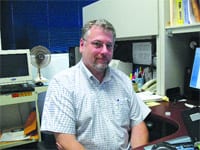Focused on the Big Picture STCC’s Sonography Program Prepares Students for High-growth Field
‘High-tech’ and ‘high-touch’ are two words commonly used to describe certain medical fields. The field of ultrasonography, said David Sloan, attracts people who are comfortable with both.
“First of all, they’re people-oriented,” he explained. “Most ultrasound exams are one-on-one, with one sonographer and a patient for a half-hour to 40 minutes at a time, so it requires someone with good people skills. A sonographer is also someone who’s interested in technology and isn’t afraid of machines with a lot of knobs and buttons.”
Sloan, who directs the Sonography program at Springfield Technical Community College, understands the career appeal of ultrasonography, which is essentially medical imaging performed with high-frequency sound waves, and differs from most other types of imaging in that it uses no ionizing radiation.
STCC’s two-year program — which runs year-round, including two eight-week summer sessions — accepts 10 students every fall from a pool of 100 to 150 applicants, he said, and most range in age from their mid-20s to mid-40s. Many are drawn to challenges that are different from those in other imaging fields.
“It’s more uniquely operator-independent,” Sloan said. “Most of the time, with something like X-ray or CT, the patient lies on the table, and the technician arranges things and pushes a button to produce the image.
“With ultrasound, the generation of the picture is operator-dependent. The technician chooses the images, so they have to be trained well enough to know what pictures to take, what’s a diagnostic image and what’s not, and what certain pathologies look like. If the physician doesn’t get the right pictures to interpret, he can’t examine the patient correctly.”
Visual Cues
Ultrasonography is used to visualize muscles and internal organs, their size, structures, and possible pathologies.
Sonographers begin by explaining the procedure to the patient and recording any medical history that may be relevant to the condition being viewed. They then select appropriate equipment settings and direct the patient to move into positions that will provide the best view. To perform the exam, sonographers use a transducer, which transmits sound waves in a cone- or rectangle-shaped beam. Although techniques vary with the area being examined, sonographers usually spread a special gel on the skin to aid the transmission of sound waves.
Viewing the screen during the scan, sonographers look for subtle visual cues that contrast healthy areas with unhealthy ones. They decide whether the images are satisfactory for diagnostic purposes and select which ones to store and show to the physician. Sonographers take measurements, calculate values, and analyze the results in preliminary findings for the physicians.
While it’s most commonly recognized by the public for its use in fetal imaging during pregnancy, ultrasound is employed in a host of applications. “It’s used pretty much everywhere in the body,” Sloan said, rattling off a list that includes vascular and arterial disease, blood clots, and a host of issues in the abdomen, gall bladder, pancreas, kidneys, spleen, prostate, testicles, breast, or any type of soft tissue in the body.
As the field expands, ultrasound is experiencing the same types of shortages that afflict many allied-health fields, making the STCC program especially appealing, said Sloan.
“It’s one of those fields where, most of the time, there is at least some chronic, low-level shortage. Sometimes it gets worse, but it hardly ever gets a lot better,” he said. “That’s partly because it’s not as mature a field as some of the other imaging modalities. Ultrasound has been around in its present form only since the 1970s.”
That quality, on the other hand, also lends the field a certain excitement. “There are a lot of new applications that are continually being developed,” he said. “As the technology gets better, they’re always finding more things to scan, more to do. And more sonographers are needed to operate the equipment.”
Indeed, the U.S. Bureau of Labor Statistics predicts employment growth for sonographers to be faster than average as it becomes an increasingly attractive alternative to other radiologic procedures. Currently, more than half of all sonographers are employed by hospitals, and most of the rest work in physician practices, medical and diagnostic laboratories, and mobile imaging services.
Students in the STCC program perform clinical rotations at hospitals across the Pioneer Valley in Massachusetts and Connecticut, Sloan noted, and most years, students don’t have trouble finding jobs.
“Of course, some years are better than others,” he told The Healthcare News. “I think that when the economy struggles, hospitals feel the pinch, too, and it can be harder to find a job. Sometimes it’s easier in a lot of other places in the country, for students who want to relocate.” Many graduates, however, are people with established families in Western Mass. who are entering sonography as a second career.
Choosing a Path
The program is accredited for general ultrasound practice by the allied-health branch of the American Medical Assoc., said Sloan, and graduates are eligible to sit for credentialing exams in ob/gyn ultrasound and abdominal ultrasound.
In addition, “we have a pilot program in association with Baystate Medical Center for echocardiography, which is ultrasound of the heart, which we started last fall” — one of the potential high-growth areas for sonography, according to labor statistics. “We have two students in it, and we’re hoping to expand that to a full program in the next year or so.”



Comments are closed.